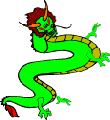
|
Dragons and Monsters |

Count the toes! A Chinese dragon has five toes on each foot; a Korean dragon has four toes; a Japanese dragon has three toes. They all agree on the number of toes, but each has a different explanation for the number. In each instance, it involves the fact that Asian dragons do not have wings. They must walk wherever they go, and dragons do enjoy travelling.
The Chinese say that dragons originated in their middle kingdom and always had five toes. As the dragon wandered, it lost toes. The farther it travelled from China, the more toes it lost. By the time it got to Korea, it only had four toes, and by the time it got to Japan, it only had three. Dragons never made it to Europe because they lost all their toes before they could make it so far.
Japan is the original dragon home, according to the Japanese, and it had three toes. The farther it travelled, the more toes it grew. By the time it reached Korea it had four, and by the time it got to China it had five. It kept growing toes and could not walk any further than China because of having too many.

Do you know how to tell the sex of a dragon? The three countries agree on this point: the male dragon holds a war club in his tail while the female dragon holds a fan in her tail.

A wise old man in the village told the people to organize together and to conquer the monster by beating drums and gongs, making bonfires, and lighting fireworks to threaten the monster. Indeed, the next time Nian came, it was frightened away by the loud noises and fireworks.
The Monster Nian
The Spring Festival (Chinese New Year) is also called "Nian" which, once upon a time, was the name of a terrible monster that devoured human beings. Every month, the monster would come down from the mountains to hunt people. The people were frightened and locked their doors long before sunset.


Chinese Festivals:
|Spring Festival (New Year)|
|Lantern Festival|
|Moon Festival|
Back to main Folklore and Legends page.
Copyright ďż˝ 2000-2001 by Tao of Meow. All rights reserved.